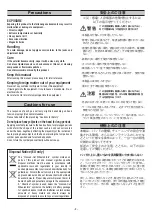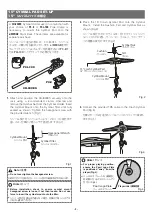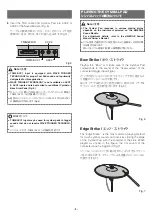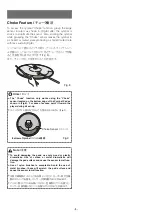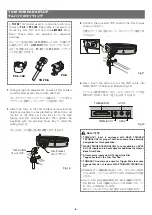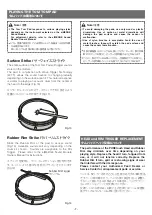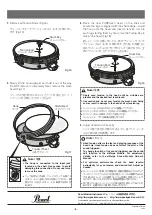
- 4 -
PLAYING THE CYMBAL PAD
シンバルパッドの奏法について
Hint /
ヒント
Note /
注意
Note /
注意
TRIGGER IN
TOM4/ACC1
ACC3
ACC2
Insert the TRS cable from Cymbal Pad into ACC2 or
ACC3 of the Sound Module (Fig. 5).
ケーブルの接続が終わったら、もう一方のジャックを音
源BOXの ACC2 または ACC3へ差し込みます (Fig.5) 。
4.
TOM4/ACC1 input may be used for cymbal pads to trigger
sounds that do not require WAVE TRIGGER TECHNOLO-
GY.
シンバルパッドは、TOM4/ ACC1 への接続も可能です。
TOM4/ACC1 input is equipped with WAVE TRIGGER
TECHNOLOGY for proper Tom Pad sound and is primarily
designated for this application.
WAVE TRIGGER TECHNOLOGY is not available on ACC2
& ACC3 inputs and is best suited for additional Cymbal or
Bass Drum Pads (Fig.5.)
タムパッドに関してはWAVEトリガー・テクノロジーの関係上
TOM4 / ACC1 へ必ず接続してください。
追加のシンバルパッド、バスドラムパッドはACC2 またはACC3へ
の接続をおすすめします (Fig.5)。
The Cymbal Pad response to various playing styles
depends on the instrument selected on the e/MERGE
Sound Module.
For adjustment details, refer to the e/MERGE Sound
Module Owner’s Manual.
ドラム音源で選択されている音色によって、各奏法への対応が異
なる場合があります。
詳しくは、ドラム音源の取り扱い説明書をご覧ください。
Fig.5
Fig.7
Bow Strike /
ボウ・ストライク
Playing the “Bow” or middle area of the Cymbal Pad
corresponds to the sound of the “head-surface” of the
connected trigger input (Fig.6).
カップ付近からエッジにかけてスティックで叩く強さによ
り音量のコントロールが可能です。
弱いタッチでは粒の立つ音色が鳴り、強めのタッチでは
クラッシュした音が発音されます (Fig.6) 。
Edge Strike /
エッジ・ストライク
The “Edge Strike” is the most common playing method
for crash cymbal sounds and involves striking the edge
of the Cymbal Pad with the shoulder of the stick. When
played as shown in the figure, the rim sound of the
connected input is triggered (Fig.7).
シンバルパッドのエッジ部(縁)を叩くとより大きなクラッシ
ュ音が得られます。スティックによる音量のコントロールも
可能です (Fig.7) 。
Fig.6


